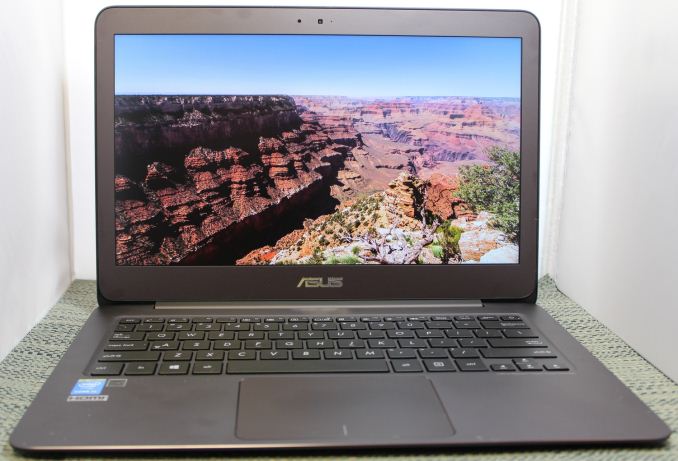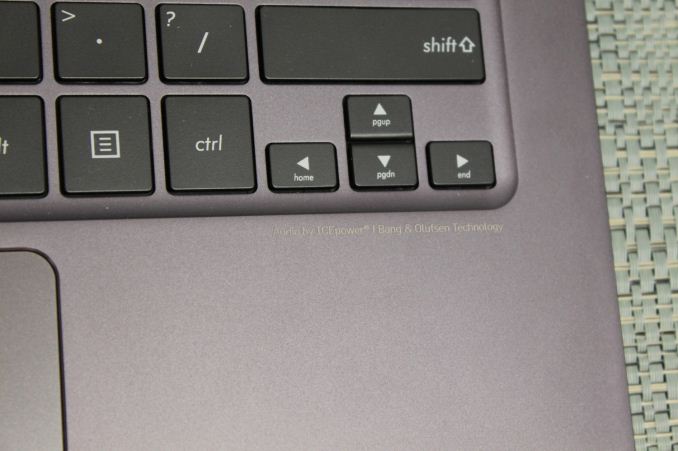The ASUS Zenbook UX305 Review
by Brett Howse on March 25, 2015 8:00 AM ESTFinal Words
ASUS has crafted an elegant experience with the UX305. The body is a sleek creation of aluminum, the device is very thin, and at 1.2 kg (2.6 lbs) in weight, it is very portable. The UX305 could easily be mistaken for a device which costs far more than its $699 starting price. When one thinks of the mid-range laptop, one would expect a thick, heavy, and boring device with a TN display panel, a spinning hard drive, and a short battery life. ASUS has thrown all of this on its head.
The Core M processor in the UX305 which we received was the 5Y10 model. For now, the higher spec 5Y71 model will not be coming to North America in this device. However the performance was surprisingly good. In shorter, burst workloads, the 5Y10 struggled to compete against 5Y71 with its much higher boost clock speed, nor could it compete against Broadwell-U based devices with their 15 watt thermal envelope. However on sustained workloads, due to the cooling solution and higher surface temperatures that ASUS has allowed, the UX305 performed much better than the Lenovo Yoga 3 Pro. Gaming was a big difference on this device, and while it is certainly not going to be the next Crysis killer, for lower demanding games like DOTA 2, it performed very well even over long periods of time.
The amount of components which lead to a better overall computing experience that ASUS packed into the UX305 is very impressive. At just $699, you still get 8 GB of RAM, and a 256 GB solid state drive. This is unheard of at this price point. The Dell XPS 13, for example, starts at $799 with just 4 GB of memory and a 128 GB drive.
The keyboard and trackpad are both quite good, especially when we consider the price, and the thin profile of the UX305. The keys had good travel, and while I would question the layout of having the power key as part of the keyboard, really the only thing missing from the keyboard experience is a backlight, and perhaps I only expect a backlight because the UX305 feels much more expensive than it is. The trackpad served me very well, and is quite large. ASUS has had some issues in the past with trackpad drivers, but I experienced no issues at all during my time with the device.
Battery life, while not class leading, is still very good, and bests any laptop we tested before 2015 with the exception of the MacBook Air under OS X. Even under a heavy load, the Core M kept its composure and ensured that the battery life did not slip away too quickly.
There are of course a few issues which need to be mentioned. The already mentioned keyboard backlight would be a great addition to the lineup, even if it was just on a higher priced model. I really do not like the display hinge which is crafed to lift the rear of the laptop up when the display is opened. It makes the laptop much more unstable, causes the display “legs” to dig into soft materials like a wooden table, and all of this is for an extra millimeter or two of height. ASUS would have been much better off with slightly thicker feet.
The display is both good and bad, but it has to be counterbalanced against the price point of this device. It is an IPS display, which is excellent to see even in a more budget offering, and it has excellent brightness and contrast levels. The matte coating is also something that many people prefer to knock the glare down. It performed very poorly in our accuracy tests though, and while that can also be attributed to the cost of the device, the post-calibration numbers on this display were fantastic. If only ASUS could take the effort to include an icc profile to help it out.
Overall, even with the knocks against it, this is a heck of a device for just $699. A Core M processor, which allows a fanless and therefore silent device, but still offers good performance, and much more performance than any other CPU which would allow for a fanless design. 8 GB of memory standard. A 256 GB solid state drive standard. A 1920x1080p IPS display, once again standard. ASUS has really raised the bar for what someone can expect in a mid-range device.












164 Comments
View All Comments
tipoo - Wednesday, March 25, 2015 - link
I was curious where Core M stood against some mid range 4-5 year old systems, namely Core 2 Duo. I checked on the Notebookcheck mobile CPU and GPU benchmarks, and it doesn't seem appreciably faster than the P8600/320M combo in an old white unibody macbook we have, for instance. The CPU scores a bit higher, not earth shattering, the GPU looks to track around the same. Is that wrong?tipoo - Wednesday, March 25, 2015 - link
Not to say that that's not impressive, going from that in 35+23 watts to a total of 5 watts, but it's not a huge upgrade for people on those systems either, apart from form factor and screen etc.Krysto - Wednesday, March 25, 2015 - link
That's great and all, except....who asked for a 5W notebook chip? Intel has been doing this for a while, moving the MAINSTREAM of the notebook market from M/H-series chips to U (CULV) series chips...and now to the even less powerful Y-series, which until Broadwell was so crap nobody dared to put it in their laptops (IVB-Y and Haswell-Y). Core M is just a slight upgrade over those.It's already happening. We're already seeing "ultrabooks" such as this Asus, and the new Macbook Air arriving with these crappy chips, and making us pay $1300 for the privilege. Why the hell wouldn't I just use an ARM chip at this point in a $500 Chromebook, and with the same quality screen and materials?
damianrobertjones - Wednesday, March 25, 2015 - link
I was with you until you mentioned 'chromebook'. That threw everything out of the window and, honestly, you'd be a bit silly to even consider such a machine.Mikemk - Wednesday, March 25, 2015 - link
You'd be silly to consider it for Chrome OS yes, but they can be good hardware with Linux Mint installed.tuxRoller - Friday, March 27, 2015 - link
Not mint, and not with that tiny amount of storage, and not at that price.If they had at least made the storage upgradable it would've been the PERFECT linux lappy.
akdj - Thursday, March 26, 2015 - link
True. Chromebooks seem silly, and an answer to nothing right now, in today's state of technology. I think Krysto, you're missing a few things...just as comparing this to a 2010 Air or an '08 MacBook. It's got 8GB of RAM. The earlier MacBooks were 2, an option of four but no more. They were either using 5400 RPM HDDs or the earliest, slowest SSD technology, they didn't aport IPS panels (nor options like HiDPI <&1000!!). You were lucky to get two, two and a half hours on the old, white plastic MacBooks, maybe an hour more on the '10 Air....they were thicker, heavier, and not anywhere close to today's GPU solutions integrated, sharing some of that RAM, in some cases 2GB of its internal/existing system memory when necessary. Along with the improvements made to OS X, this is a machine built for 'Most'......Not you and I. Different needs, all that but plenty are getting by everyday without turning a laptop or their desktops at home on. iPads, your Nexus or Samsung tablet of choice -- even today's smartphones smoke those older MacBooks for all reasons mentioned above; portability, longevity, 'speed' (with PCIe storage now, quick NAND solutions in tabs), and overall function.
There's a WHOLE lot of folks using their iPad for their email, facebook, casual gaming and web surfing, entertainment and media, constant, 'everywhere' connectivity radios and phenomenal displays you can throw in a bag and forget it's there. Even charge it with a cigarette lighter. Same applies to today's phablet phones ...as we've seen tab sales drop whether it's due to over saturation of the tablets in those who already 'want them', a slower upgrade cycle and/or the 'phablet' craze with incredible, HiDPI 5-6" display phones in our pockets...with the SAME power as their tablet counterparts (some compared favorably in this review ...IOW, iPhone 66/6+, Note 4 and incoming S6, new LGs, HTCs and iPhones, these 'phones' are going to be competing even more favorably this year to these ultra book scores, that's cool!)
Point being 'Most' folks haven't the needs or just plain 'wants' those of us frequenting Anandtech are looking at for our next computer. That said, a dozen hours, two pounds and those improvements are all fine choices for someone not rendering video or manipulating 200 RAW 50mpxl images 'on the run' --- the perceived and 'real speed' increases via SSD storage, the iGPU and fabless quiet design might just make for an excellent commuter computer for many of us, at just 7-$999! Like the new MacBook, it's got a place in the marketplace for the masses but if it's not the solution you're lookong for the Broadwell 35/45 watt MacBook pro, XPS 15 and 17" workstations, etc ...they'll be here sooner than later and from all things I've seen, other than maybe a 5-8% power increase and savings over Haswell, there's plenty of options on the market today that cover the bases
I'll be 44 this year and started with an Apple IIe. What a cool time to be a 'geek'!
J
eanazag - Monday, March 30, 2015 - link
If Chromebooks could do RDP, than they would make decent thin clients. Otherwise, I don't find much value in them except for cases where you want your device to only be a browser from a management standpoint.Marc GP - Thursday, April 9, 2015 - link
They can.https://chrome.google.com/webstore/detail/chrome-r...
8steve8 - Thursday, April 23, 2015 - link
that's not RDP, that's chrome remote desktop. not a terrible solution, but in my limited experience had issues vs RDP.